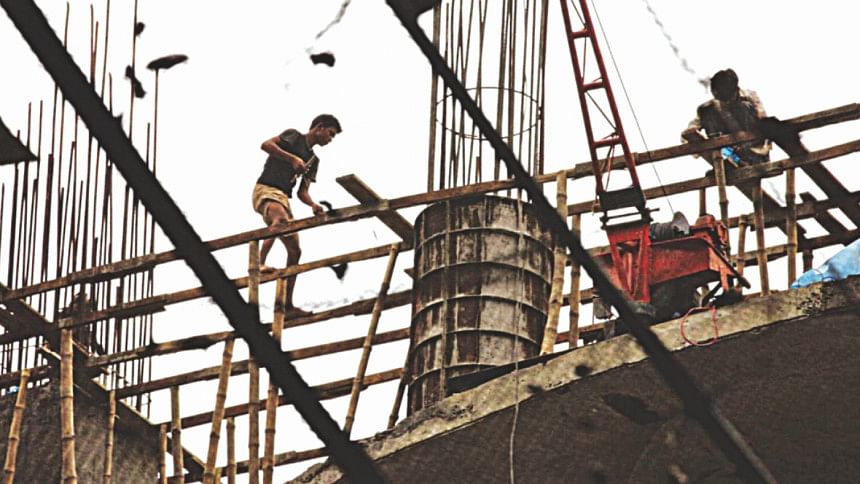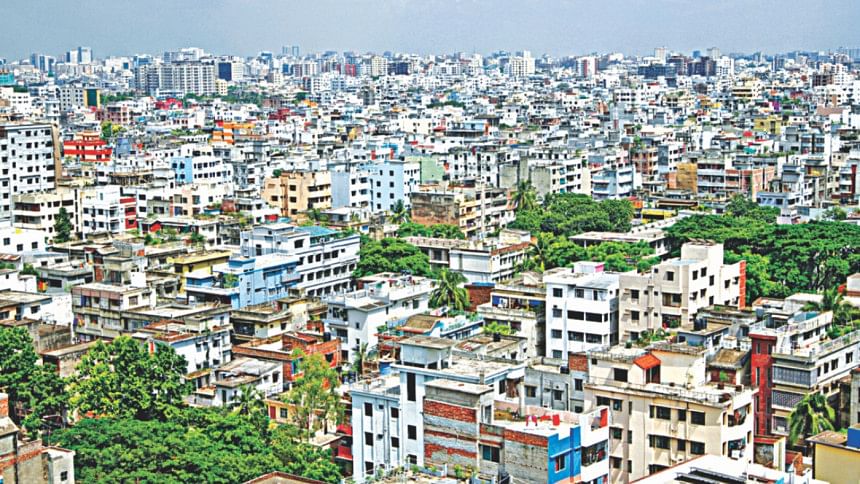Real estate development

Real estate development is a business activity concerned with land and construction that provides value-adding services by developing residential, commercial, institutional, industrial and integrated projects and related infrastructure. The concept of real estate in Bangladesh emerged after liberation. Over time, real estate has become a subject of keen interest for the general public, businessmen and other stakeholders. The real estate and housing sector is one of the main drivers of any nation's economic development and industrialisation. In Bangladesh, real estate has emerged as a crucial sector of our economy. It has a huge multiplier effect on economic activities and therefore, is a big driver of economic growth. It is one of the largest employment-generating sectors after agriculture and garments. Not only does it generate direct and indirect employment opportunities, it also stimulates demand for ancillary industries, for example steel, cement, tiles and sanitary ware, cable and electric ware, paint, glass and aluminium, brick, building materials, and consumer durables.
As the extent of globalisation spreads, the process of urbanisation increases. It has increased the momentum of urbanisation in both developed and developing countries. The ever-increasing urban population is creating an increasing demand for housing and shelter. The right to shelter is a fundamental right embodied in both the Universal Declaration of Human Rights and the Constitution of Bangladesh. But Bangladesh being a poor developing country, it is almost impossible for the government to ensure housing for all.
In Bangladesh, the rate of urbanisation is very high, aggravated by the high population growth rate and rapid rural-urban migration. The trend of urban growth in this country is about 3.25% per annum (Islam, 2012). This will change and increase Bangladesh's demand for housing. To accommodate the increasing urban population, real estate development is essential to provide appropriate housing in Bangladesh.
CONTRIBUTION OF THE REAL ESTATE SECTOR
The real estate sector is the growth centre for the development of any economy. As one of the most densely populated countries in the world, Bangladesh has been experiencing severe housing shortages. With the majority of the population in the middle and low-income groups, ensuring housing for all is difficult here. The private sector housing developers have met a large proportion of the national housing demand in the last 40 years.
But Bangladesh also suffers from a scarcity of land. It is an agriculture-based country where the urbanisation level of 28% (Islam, 2012) is substantially lower than in developed countries. However, urban centres are housing huge populations. People are migrating to urban areas because of both push and pull factors, thereby creating an urban sprawl. Meeting the huge demand for housing has become a challenge for the government. The real estate sector in Bangladesh has been operating for four decades, within which period it has fluctuated greatly. Today the sector plays a major role in the national economy, contributing up to 7.08% of the national GDP in FY 2013-14 (BBS, 2014). In addition, the sector also contributed to the national economy through linkage industries, such as MS bar, cement, brick, sand, ceramic tile, paint and other fixtures and fittings. Real Estate and Housing Association of Bangladesh (REHAB) declared that the sector along with its linkage industries contributed about 12% to the national GDP in 2014.
DEMAND FOR REAL ESTATE HOUSING IN BANGLADESH
There are some other socio-economic reasons behind the strong demand for the housing market besides the demand-supply interaction. The most important one is the change in family structure. Whereas in the past extended or joint families were the norm, in the last two decades, nuclear families consisting of parents and one or two children have become more prevalent. Such families find it convenient to live in apartments with two or three rooms. In addition, the services and security offered in apartments are usually better than those of other housing types. Most of the apartment complexes and high-rises provide spaces for community activities within the premises. Such spaces usually accommodate a play area for children, a community centre for ceremonies, a prayer room, etc. Moreover, it has been obligatory for an apartment building community to have a management consisting of the apartment owners responsible for the overall building. All these reasons have been shaping the apartment buyers' decisions. A significant number of the buyers are wage-earners in foreign countries and remittances have been a major source of capital for apartment purchase.

The real estate business has been flourishing in Bangladesh for a considerable period of time, and has seen tremendous growth in Dhaka. After a haphazard start, it has gradually become more systematic and organised. However, land record management in Bangladesh is very ambiguous and people are apprehensive about land ownership and its legal procedures. People cannot trust all the real estate companies equally. Only the top professional companies are doing well. So it is necessary to establish a strong legal framework for real estate development. The rights of citizens should be protected through proper transparency and accountability.
REAL ESTATE TRADE AND THE INVESTMENT CYCLE
Raw land is a key feature of the real estate cycle as it is the focal point of construction and expansion of business. The most characteristic feature of a real estate boom is the speculation of large under-developed land and the sale of lots in subdivisions to small investors. It is increasingly prevalent in Dhaka city and its surroundings. These practices are the main constraints of real estate business and building construction, and the price of raw land becomes very uncompetitive.
The fact that real estate cycles coincide with major booms and that they are not greatly affected by minor cycles is consistent with the theory that real estate is not simply reacting to other cycles, but is a key factor in causing the major booms and depressions.
As real estate cycle history shows, intermediate and minor cycles have occurred in the midst of real estate cycles. Most major upswings are interrupted by minor recessions, but downswings are seldom interrupted by revivals. For example, there may an intermediate recession during a real estate boom, whereas the depression following the boom may be much more severe. After an intermediate upswing during the Great Depression, which collapsed the following year, producers' equipment recovered, but real estate remained depressed.
Since most real estate buyers borrow funds, real estate prices and construction are influenced by changes in both income and interest rates. However, the short business cycles do not greatly affect real estate prices; only minor variations in real estate prices may occur and values generally move upward without serious setbacks. The real estate boom forces are much more powerful and dynamic than those of the business cycle. Real estate cycles can overcome lesser cycles (caused by credit shocks, for example). Urban development is capable of endowing building booms with considerable momentum of their own, independent of what is happening to investment in other sectors or to national income.
Another effect of real estate booms on business is a crowding-out of investment funds. When home-ownership is employed as a leveraged investment, its support can be accepted quite realistically. The dynamics of real estate demonstrate that land speculation and the construction industry have endogenous forces consistent with the theory of real estate as a significant causal factor in the major cycles. These are the major characteristics of the real estate market that formulate the real estate cycle.
In the years 1990-92, after a shift in the form of government, Bangladesh faced sudden changes in economic practice. Real estate is heavily dependent on investors, but investors were not interested in investment during this period. So, during this period the country faced a recession in the real estate market. The gradual increase in investment following the recession resulted in a huge supply in the real estate market in 2004-06. The real estate business attracted investors by providing lots of good products. Subsequently, it also attracted many new entrepreneurs who lacked relevant experience and adequate infrastructure backup to invest in this sector. In the period from 2006-08, Bangladesh faced a changed socio-political scenario. All sectors of the economy, including real estate, showed declining trends during this time. Many novice realtors ceased doing business. After this situation ended, the economy took off again. People resumed investing and the real estate sector experienced a boom again during 2009-11. But this boom was unlike the previous one of 2004-06 and did not last long. Since 2013, Bangladesh has been experiencing a decline a real estate investment by individual buyers, and the sector has not seen any hopeful signs of recovery as yet.
CONCLUSION
We all know that after food and clothing, housing is one of the basic rights of every citizen. To meet this fundamental need, the private real estate and housing developers initiated a real estate development venture a couple of decades back, especially to address the growing urban housing problem. Private sector initiative sparked a remarkable boom in investment and development activities. The relationship between real estate prices and general economic conditions have an extensive history, beginning with the ways in which long swings in construction and price development were synchronised with long swings in aggregate economic activity.
The sector has extensive potential to attract investment to its various segments. However, progress is possible only with the joint efforts of both the industry and the government. The government must provide fiscal incentives to developers to build low-cost and affordable housing for the masses. Realistic and long-term policy guidance for the real estate sector must be taken by government to encourage investment and development in Bangladesh's real estate. The notion of 'affordable housing' must be popularised to set a minimum standard of accommodation for all citizens. Ensuring housing for all is obligatory for the development of a nation. Without proper accommodation, we cannot develop a capable work force for contributing to the national economy. Judging the multi-sectoral nature of housing, it is clear that one or two isolated initiatives will not be enough to solve the urban housing problem. The government should come forward and take the lead role; private developers can only be an ancillary actor in this sector.
The writer is an Engineer-Planner and the Managing Director of Sheltech (Pvt.) Ltd.
References
BBS, 2014. Gross Domestic Product of Bangladesh at Current Prices. [pdf] Bangladesh Bureau of Statistics. Government of the People's Republic of Bangladesh. Available at: http://www.bbs.gov.bd/WebTestApplication/userfiles/Image/GDP/GDP_2013-14.pdf [Accessed on: January 15, 2015]
Foldvary, F. E., 1991. Real Estate and Business Cycles: Henry George's Theory of the Trade Cycle. Latvia University of Agriculture, Latvia.
Islam, N., 2012. Urbanization and Urban Governance in Bangladesh. Annual Global Development Conference on “Urbanization & Development: Delving Deeper into the Nexus”. Budapest.
REHAB, 2014. Real Estate and Housing Association of Bangladesh. [Online] Available through: http://www.rehab-bd.org/ [Accessed on: December 14, 2015]
Sivitanidou, R., n.d. Basic Real-Estate Economics. Retrieved from: harvard.edu. [Accessed on: June, 2013]

 For all latest news, follow The Daily Star's Google News channel.
For all latest news, follow The Daily Star's Google News channel. 



Comments